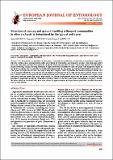Por favor, use este identificador para citar o enlazar a este item:
http://hdl.handle.net/10261/259679COMPARTIR / EXPORTAR:
 SHARE SHARE
 CORE
BASE CORE
BASE
|
|
| Visualizar otros formatos: MARC | Dublin Core | RDF | ORE | MODS | METS | DIDL | DATACITE | |

| Título: | Structure of canopy and ground-dwelling arthropod communities in olive orchards is determined by the type of soil cover |
Autor: | Castro, Jesús; Tortosa, Francisco S.; Carpio, Antonio J. CSIC ORCID | Palabras clave: | Olive groves Undergrowth Arthropod community Functional diversity Planted cover Spontaneous cover Bare ground Unweighted quantitative descriptors |
Fecha de publicación: | 2021 | Editor: | Czech Academy of Sciences | Citación: | European Journal of Entomology 118: 159-170 (2021) | Resumen: | The intensification of agriculture in olive groves, especially the modification or elimination of spontaneous vegetation, alters the relationships in arthropod communities and reduces their interactions and ecosystem services. This study was carried out in nine olive groves in which there was either a planted cover crop, spontaneous cover crop or bare ground. The interactions of ground-dwelling, canopy and flying arthropods in trophic webs were calculated for each olive grove soil management regime at the family level taking into consideration their different functional traits: feeding guilds, specific agricultural traits and trophic level. Olive groves with spontaneous cover had trophic webs with a higher number of plausible links between arthropod families and a more balanced distribution of specimens among trophic levels compared to those with planted cover and bare ground. There was a similar number of arthropod families consisting of both pests and their natural enemies in the planted cover regime, while olive groves with bare ground had simpler trophic webs. The complexity of plausible trophic links was greater in olive groves with spontaneous plant cover despite the similar values for family richness in the three-olive grove soil management regimes. Qualitative values (such as functional traits) were more diverse in agroecosystems with spontaneous plant cover in which there were more sources of food. | Versión del editor: | https://doi.org/10.14411/eje.2021.017 | URI: | http://hdl.handle.net/10261/259679 | DOI: | 10.14411/eje.2021.017 | E-ISSN: | 1802-8829 |
| Aparece en las colecciones: | (IREC) Artículos |
Ficheros en este ítem:
| Fichero | Descripción | Tamaño | Formato | |
|---|---|---|---|---|
| strucover.pdf | 1,25 MB | Adobe PDF |  Visualizar/Abrir |
CORE Recommender
WEB OF SCIENCETM
Citations
1
checked on 28-feb-2024
Page view(s)
94
checked on 15-may-2024
Download(s)
106
checked on 15-may-2024
Google ScholarTM
Check
Altmetric
Altmetric
Este item está licenciado bajo una Licencia Creative Commons

